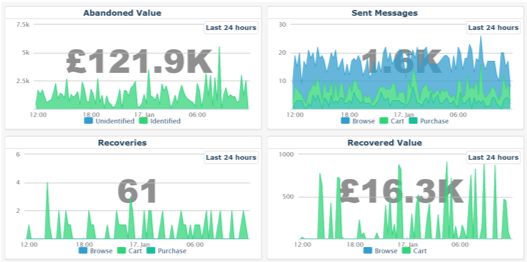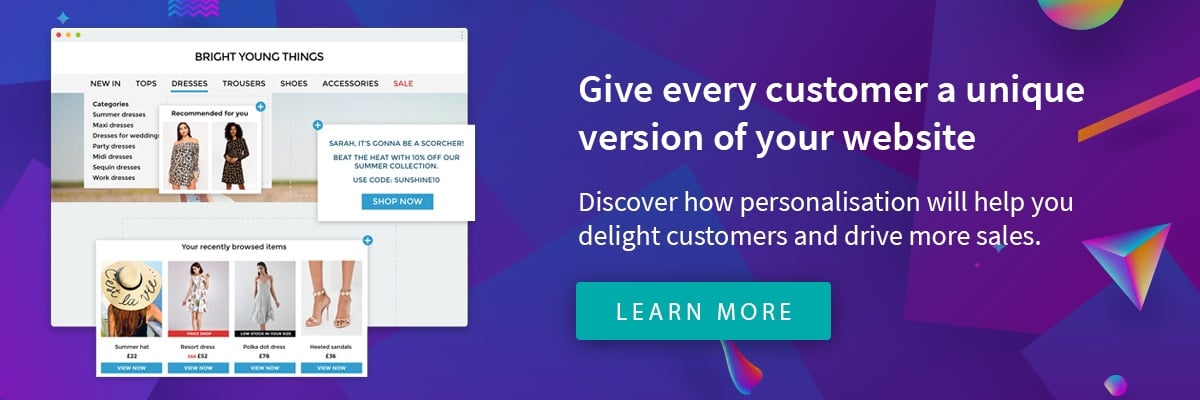Is building a highly personalised customer experience high on your agenda? If so you’re not alone. The overwhelming majority (98 percent) of marketers believe personalisation helps to advance customer relationships.
To enjoy the benefits of personalisation, having the right technology in place is crucial. But which platform to choose? With so many options out there, choice paralysis is a real danger — just glance at the marketing technology landscape and you’ll know what we mean!

When it comes to picking personalisation technology, choosing between an all-in-one platform or a point solution is a sensible place to start. This blog post explores the differences between the two so you can decide which is best for your business.
All-in-one personalisation platform vs. point solutions
A point solution is a piece of software that solves one particular problem. For example, a tool that personalises email content but doesn’t offer a way to personalise website content. While point solutions may seem attractive as they meet a single need without unnecessary extras, marketers will often find themselves having to use multiple point solutions in combination with each other.
In contrast, an all-in-one platform is single piece of software or solution that meets a wide variety of needs for your business. When it comes to personalisation, an all-in-one platform allows you to personalise content across multiple channels to create a seamless customer experience.
Further reading: 11 Must-haves for Your Personalisation Technology
Pure360 offers an all-in-one personalisation platform because we’ve concluded it’s the best to help our customers excel. Let’s dive into the detail and explain why:
Unified data
An all-in-one personalisation platform keeps all of your data in one place. Using a single customer view to power your multi-channel personalisation eliminates the guess work and improves results.
An all-in-one platforms means you can easily feed website browsing behaviour into email campaigns. A person browsing your website can be retargeted with relevant emails based on which pages or products they viewed.
Basing personalisation on a well-rounded view of your customers means it’s more likely to resonate. In contrast, personalisation based on fragmented data can lead to a disjointed experience.
Flexibility
Brands that have a number of point solutions in place have to spend time ensuring they can all communicate. This is not always easy or possible. If your various point solutions fail to communicate effectively, you may be unable to fully optimise your personalisation strategy.
Before coming to us for help, Fitness Superstore discovered this the hard way. Lack of communication between point solutions left the team unable to update their own cart abandonment emails. They had to approach the vendor every time they needed to make an amend.
An all-in-one platform gives you the flexibility to tweak your marketing communications across multiple channels and optimise your way to success.
Strategic thinking
When using point solutions, it’s all too easy for your thinking to get stuck in silos. A unified solution, on the other hand, allows you to see the big picture. You can think strategy-first instead of channel-first.
Rather than optimising individual channels, you can look at how personalisation can be used to create a seamless cross-channel experience.
Time saving
Most marketing teams don’t have the luxury of time to spare. Using point solutions means jumping from task to the next in different platforms. Then there’s the time spent on cobbling insights together and reporting.
Having an all-in-one personalisation platform means your team can report on everything from one place. A much more efficient way to operate.
Easier management
An all-in-one personalisation platform is much easier to manage than multiple point solutions. You have one simple user interface to deal with and only one system to learn. You can run one session for every user, rather than having to train lots of people on a bunch of different bits of software.
If your point solutions need to talk to each other (which they should if you’re trying to deliver cross-channel personalisation), then be prepared to spend a lot of time managing this process. The set up alone might require extensive work on from all parties.
Consistent support
What happens when you need help with a campaign that involves using a number of different point solutions? Calling a bunch of different teams can end up being a bit of a nightmare.
Things are much simpler with an all-in-one solution. You can access all the support you need in one place. You will also benefit from a single point of contact who will understand your overall strategy.
Cost effective
The upfront cost of an all-in-one solution may seem more intimidating than spending less on each individual point solutions. But by the time you’ve bought every point solution you need, costs mount up.
It tends to be cheaper to buy everything you need for cross-channel personalisation in one place.
Provable ROI
As a marketer, demonstrating the ROI you’re delivering is crucial. Especially if you want to keep moving up the ranks.

Marketing ROI is much easier to work out if you have a single solution in place. With Pure360 you can generate impressive reports in seconds that show revenue uplift attributed to personalisation. Hello, promotion!
Takeaway
There are a number of reasons why an all-in-one personalisation platform makes more business sense for many brands. A unified solution brings your data into one place, improving the potential to personalise effectively.
Not only that, but an all-in-one personalisation platform is more flexible. It enables joined up strategic thinking, saves time and money, is easier to manage and support, and makes reporting on ROI a lot simpler.
To learn how our client discovered the benefits of an all-in-one personalisation platform for themselves, read Fitness Superstore’s case study.

